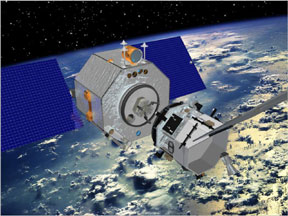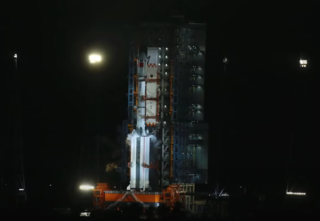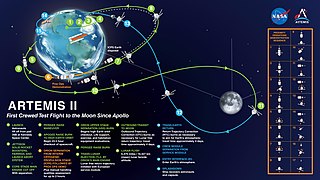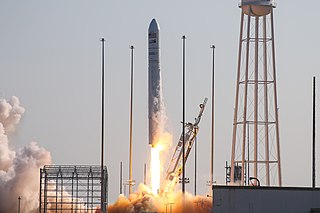
SSL, formerly Space Systems/Loral, LLC (SS/L), of Palo Alto, California, is a wholly owned manufacturing subsidiary of Maxar Technologies.

Landsat 7 is the seventh satellite of the Landsat program. Launched on 15 April 1999, Landsat 7's primary goal is to refresh the global archive of satellite photos, providing up-to-date and cloud-free images. The Landsat program is managed and operated by the United States Geological Survey, and data from Landsat 7 is collected and distributed by the USGS. The NASA WorldWind project allows 3D images from Landsat 7 and other sources to be freely navigated and viewed from any angle. The satellite's companion, Earth Observing-1, trailed by one minute and followed the same orbital characteristics, but in 2011 its fuel was depleted and EO-1's orbit began to degrade. Landsat 7 was built by Lockheed Martin Space Systems.
Orbital Sciences Corporation was an American company specializing in the design, manufacture, and launch of small- and medium- class space and launch vehicle systems for commercial, military and other government customers. In 2014, Orbital merged with Alliant Techsystems to create a new company called Orbital ATK, Inc., which in turn was purchased by Northrop Grumman in 2018. The remnants of the former Orbital Sciences Corporation became a subsidiary of Northrop Grumman, known as Northrop Grumman Space Systems.

Orbital Express was a space mission managed by the United States Defense Advanced Research Projects Agency (DARPA) and a team led by engineers at NASA's Marshall Space Flight Center (MSFC). The Orbital Express program was aimed at developing "a safe and cost-effective approach to autonomously service satellites in orbit". The system consisted of two spacecraft: the ASTRO servicing satellite, and a prototype modular next-generation serviceable satellite; NEXTSat. The mission launched from Cape Canaveral Air Force Station on 8 March 2007, aboard an Atlas V expendable launch vehicle. The launch was part of the United States Air Force Space Test Program STP-1 mission.
The STAR-2 Bus is a fully redundant, flight-proven, spacecraft bus designed for geosynchronous missions.

Cygnus is an expendable American cargo spacecraft developed by Orbital Sciences Corporation but manufactured and launched by Northrop Grumman Space Systems as part of NASA's Commercial Resupply Services (CRS) program. It is usually launched by Northrop Grumman's Antares rocket from the Wallops Flight Facility, although three flights were on ULA's Atlas V and three are planned for SpaceX's Falcon 9, in both cases launching from Cape Canaveral Space Force Station. It transports supplies to the International Space Station (ISS) following the retirement of the American Space Shuttle. Since August 2000, ISS resupply missions have been regularly flown by the Russian Progress spacecraft, as well as by the European Automated Transfer Vehicle, and the Japanese H-II Transfer Vehicle. With the Cygnus spacecraft and the SpaceX Dragon, NASA seeks to increase its partnerships with domestic commercial aviation and aeronautics industry.
Space Infrastructure Servicing (SIS) is a spacecraft concept being developed by Canadian aerospace firm MDA to operate as a small-scale in-space refueling depot for communication satellites in geosynchronous orbit.
The Mission Extension Vehicle (MEV) is a spacecraft that extends the functional lifetime of another spacecraft through on-orbit satellite servicing. They are 2010s-design small-scale in-space satellite-refueling spacecraft first launched in 2019. The MEV spacecraft grew out of a concept proposed in 2011 by ViviSat, a 50/50 joint venture of aerospace firms US Space and Alliant Techsystems (ATK). The joint venture was created in 2010 for the purpose of designing, producing and operating the MEV program.

A space tug is a type of spacecraft used to transfer spaceborne cargo from one orbit to another orbit with different energy characteristics. The term can include expendable upper stages or spacecraft that are not necessarily a part of their launch vehicle. However, it can also refer to a spacecraft that transports payload already in space to another location in outer space, such as in the Space Transportation System concept. An example would be moving a spacecraft from a low Earth orbit (LEO) to a higher-energy orbit like a geostationary transfer orbit, a lunar transfer, or an escape trajectory.

The Robotic Refueling Mission (RRM) is a NASA technology demonstration mission with equipment launches in both 2011 and 2013 to increase the technological maturity of in-space rocket propellant transfer technology by testing a wide variety of potential propellant transfer hardware, of both new and existing satellite designs.
On-orbit satellite servicing refers to refueling or repairing space satellites while in orbit.
On-Orbit Servicing, Assembly, and Manufacturing 2 (OSAM-2), formally known as Archinaut, was a technology demonstration project aimed at developing the necessary additive manufacturing technology to build large-scale structures in space. Phase 1 of the project started in 2016 and was funded by a NASA contract worth US$20 million; it was performed by a partnership between Made In Space (MIS), Northrop Grumman, and Oceaneering Space Systems. Its formal name was "Versatile In-Space Robotic Precision Manufacturing and Assembly System".
Intelsat 10-02 is a communications satellite operated by Intelsat. Intelsat 10-02 is the first operational communications satellite to have its service life extended by Mission Extension Vehicle-2, while still in service, in 2021.

Shijian is a series of satellites built and operated by the People's Republic of China. Some Shijian-series satellites have drawn significant concerns from the United States government and space observers who cite unannounced launches, undisclosed sub-satellites deployed in orbit, unusual orbital maneuvers, and demonstrated rendezvous proximity operations (RPO) including the close inspection and towing of other satellites.

RSat-P is a microsatellite built by the United States Naval Academy (USNA) in Annapolis, Maryland. The small spacecraft is a 3U CubeSat intended to demonstrate capabilities for minor in-orbit repair of a much larger, conventional spacecraft.

This article documents expected notable spaceflight events during the year 2025.

Cygnus NG-16, previously known as Cygnus OA-16, was the sixteenth flight of the Northrop Grumman robotic resupply spacecraft Cygnus and its fifteenth flight to the International Space Station (ISS) under the Commercial Resupply Services (CRS-2) contract with NASA. The mission was launched on 10 August 2021 at 22:01:05 UTC, for a (planned) 90-day mission at the ISS. This was the fifth launch of Cygnus under the CRS-2 contract.

NG-18 was the eighteenth flight of the Northrop Grumman robotic resupply spacecraft Cygnus and its seventeenth flight to the International Space Station (ISS) under the Commercial Resupply Services (CRS-2) contract with NASA. The mission successfully launched on 7 November 2022 at 10:32:42 UTC. This was the seventh launch of Cygnus under the CRS-2 contract.
OSAM-1 was a cancelled NASA spacecraft designed to test on-orbit refilling of satellites. It was previously known as Restore-L.

Orbit Fab is an American startup based in Lafayette, Colorado, United States, that develops in-space refueling systems for satellites.












